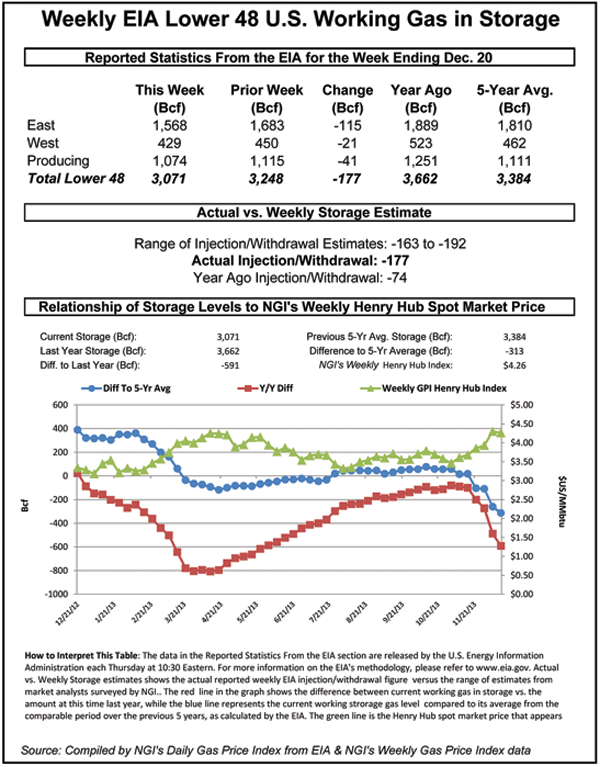Markets | NGI All News Access | NGI Data
Cash Holds, But Futures Traders See $4.60 Gas
Deliveries of weekend and Monday gas were unchanged on average in Friday’s trading, with eastern and Northeast weakness for the most part offset by gains in the Midwest. At the close, January had fallen 2.6 cents to $4.407 and February was down 10.8 cents tgo $4.368. February crude oil added 77 cents, to $100.32/bbl, the first time oil has traded above $100 in two months.

The Energy Information Administration (EIA) on Friday reported a withdrawal of 177 Bcf in its storage inventory report, an amount largely anticipated by the market, and prices initially dipped but finished close to pre-report levels.
Weekend and Monday prices rose a dime or more in the Midwest as brutal cold was forecast to make its way south over the weekend. Forecaster Wunderground.com predicted that the high of 41 in Minneapolis on Friday would fall to 35 on Saturday and plunge to 5 degrees by Monday. The normal high in Minneapolis is 24. Chicago’s high of 46 degrees on Friday was expected to slide to 41 Saturday then drop to 11 on Monday; the seasonal high is 33. Omaha’s 60 degrees on Friday was anticipated to drop 10 degrees by Saturday and fall another 20 degrees for a high Monday of 30. The normal highin late December is 33, the forecaster said.
The National Weather Service (NWS) in Minneapolis said its immediate long-term concern continued to be the timing of an Arctic cold front and the potential for blizzard conditions developing Saturday into south central Minnesota. “Following that will likely be the coldest air of the season…which will linger into at least midweek next week,” said forecasters.
Quotes for weekend and Monday gas on Alliance added a nickel to $4.73, and gas at the Chicago Citygates hit $4.78, up 9 cents. Deliveries to Northern Natural Ventura gained 17 cents to $4.75, and gas at Demarcation rose by 15 cents to $4.70. ANR SW added 9 cents to $4.31.
Eastern points for weekend and Monday were lower as a warming trend was forecast. Gas on Transco-Leidy fell 14 centsto $3.20, and Dominion gas was quoted at $3.50, down 7 cents. Gas on Tetco M-3 plunged 33 cents to $3.94, and gas headed for New York City on Transco Zone 6 fell a nickel to $4.51.
NWS forecasters in suburban Philadelphia said “the high to our southwest will start to move to the east on Saturday, pushing offshore Saturday afternoon/evening. A weak [low] will cross the region Saturday morning but with limited moisture in place, it should remain dry across the forecast area…The continued southwest flow will help to keep U.S. much warmer than normal. Maximum temperatures will generally be around 10 degrees above normal across the forecast area. Expect maximum temperatures to be in the lower to middle 40s across the north to around the middle 50s as you head toward the coast.”
New England points proved to be Friday’s biggest movers, and in spite of some recent quotes on Algonquin as high as $20 or more, analysts saw prices vulnerable to a decline. A liquefied natural gas cargo ship arrived at Canaport on Dec. 22 “so they are OK for the time being,” said a Northeast marketer. “You’ve got [production from] Sable as well as Distrigas [into Boston] so I think there is more downside than upside with that $20 [Algonquin] basis.”
Gas at the Algonquin Citygates fell 35 cents in thin trading to $8.64, and deliveries to Iroquois Waddington added 31 cents to $5.51.
Futures traders felt the market was “heavy” on Friday, but “overall its cold outside and you have to think this market will keep looking up,” said a New York floor trader. “I think there was some profit taking today, and I think the market can rally up to $4.60 to $4.62, but after that you may be looking at a top.”
The longer-term weather outlook for eastern energy markets has turned somewhat milder. WSI Corp. in its 11-15-day outlook showed a broad ridge of colder than normal temperatures from Chicago and Wisconsin west to the Pacific Northwest. Above-normal temperatures were forecast in the Southeast, and the remainder of the country was shown to be normal. Friday’s foreacast “trended colder over the West and warmer over the East when compared to the previous forecast. Forecast confidence is considered near average as the medium-range ensemble model guidance solutions have rounded into better agreement this morning.”
Risks to the forecast are “in place for the West down in through CAISO [California Independent System Operator] late under what looks to be another cold trough passage. Temperatures could run colder than forecast over the Midwest and Great Lakes region late in the period if the ensemble model solutions are too retrogressive with the pattern.”
Analysts see a bullish tone to the market following the EIA’s storage report, which coincided with the expiration of the January futures contract, said Jim Ritterbusch of Ritterbusch of Ritterbusch and Associates, who expected a 175 Bcf draw. “This opinion is based on the possibility that some additional weather-related production disruptions could be accentuating seasonal supply declines…”
Other traders also were also looking for a triple-digit draw. A Dow Jones survey of 12 traders and analysts showed an average 178 Bcf decline, and Houston-based IAF Advisors calculated a 176 Bcf pull. Bentek Energy was looking for a 175 Bcf withdrawal. Last year, 74 Bcf was withdrawn and the five-year average stands at 125 Bcf.
© 2024 Natural Gas Intelligence. All rights reserved.
ISSN © 1532-1231 | ISSN © 2577-9877 |
